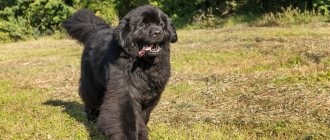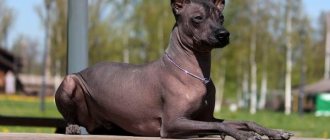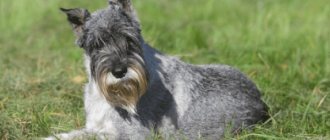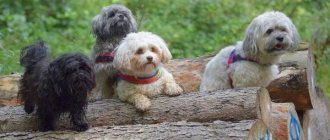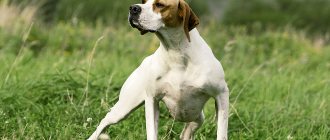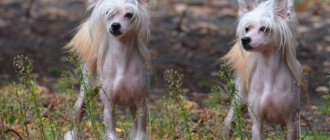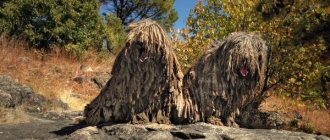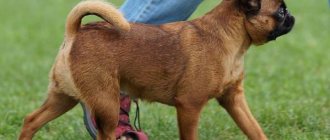The Newfoundland is a unique dog, which is also called a diver. Her impressive size and menacing appearance do not at all combine with her surprisingly good-natured character. These dogs have no aggression towards any living beings at all; they love to serve people and help those who are weaker. Because of this, the Newfoundland will not become a watchman or guard; it simply cannot bite a person. He is good-natured, sociable, obedient, affectionate and loyal. But before getting a dog of this breed, you need to study its description, pros and cons, and reviews from owners.
- Head
- Education and training
- Content Features
Newfoundland - dog breed: breed characteristics, breed standard, height, weight
The main feature of the breed is its large weight and height with good maneuverability and mobility. Dogs, despite their enormous mass, have good control over their bodies. Females are slightly smaller than males. The contours of the head and entire body are more refined. Excess weight is not welcome, as it provokes the occurrence of many diseases.
Characteristics:
- Height for males is 69-75 cm, and for females 65-69 cm
- Weight for males up to 70 kg, and for females up to 55 kg
- Rectangular body with fleshy and strong paws
- The tail is saber-shaped, slightly raised above the level of the back.
- The head is large and characterized by rectangular contours
- The teeth are straight and even, closing like claws or scissors
- The withers are large and developed. For females, its size is not adjustable
Newfoundland - dog breed: breed characteristics, breed standard, height, weight
Appearance
The Newfoundland is a large dog with a powerful, athletic build. With its luxurious thick fur and head shape, it resembles a bear. Due to his colorful appearance, his images are often found on stamps and coins.
The height of dogs at the withers is on average 66-71 cm, in some individuals it reaches 80 cm. Weight is 54-68 kg, sometimes more. Despite such large size, the dog does not look heavy or clumsy. She is harmoniously built, her movements are well coordinated. The appearance features are determined by the 1996 standard, which is not very different from the first one adopted in the 19th century.
Photos of Newfoundlands:
Head
The skull is large, wide, convex, with a pronounced occipital protuberance. The stop is not sharp, but clearly noticeable. The muzzle is quite short, almost square in shape. The cheeks are soft, the corners of the mouth are clearly defined. The lips are fleshy, hang down, but do not reveal teeth. There are no folds on the muzzle.
The nose is large, wide, black or brown, depending on the color of the dog. The jaws are powerful, the teeth are large. The bite can be either straight or scissor.
The eyes are small, dark brown in color; in brown individuals they may be lighter. The eyelids should not droop. The eyes are set quite deep and slightly slanted. Because of this, the look seems sad. The ears are medium-sized, triangular, with rounded tips. Set closer to the back of the head, hanging down.
Torso
The physique is massive, muscular, strong bones. The body shape is square. In bitches it may be more elongated in length. The neck is muscular, without dewlap. The back is wide, straight, the croup is sloping. The chest is deep, voluminous, but not wide, the stomach is not tucked.
The tail is wide at the base, tapering towards the tip. It is strong and acts as a rudder in the water. When at rest, it is lowered, reaches the hock joints, and bends slightly. Never rolls over on its back.
Limbs
The forelimbs are straight and muscular. Remain parallel even when the dog moves. The shoulders are directed back, the elbows are close, the pasterns are slightly inclined. The hind legs are powerful, with wide, muscular thighs. The shins are strong, the knee joints are pronounced. Hocks parallel, short.
The paws are wide and rounded. The fingers are gathered into a ball, with membranes between them. The movements are light, sweeping, free. The dog is able to run a long distance and swims very well.
Coat and colors
Double wool, water-repellent. The dog's entire body is covered with long, thick, fairly stiff guard hairs. They are usually straight and smooth, but can be slightly wavy. The undercoat is double, very thick and soft. It is especially dense on the chest and rump. Thanks to these features of their coat, these dogs are not afraid of severe frosts and cold water, but do not tolerate heat well.
The hair on the tail is long, without undercoat, and the paws have feathers. On the head it is shorter, thinner and softer. There is no collar on the chest and neck that would prevent the dog from swimming. The soft, silky undercoat, which can be combed out, is recommended to be spun. This wool is good for knitting socks, mittens, sweaters, and anti-radiculitis belts. Things turn out warm and waterproof.
The most common color found in Newfoundlands is black. The color is rich, anthracite, uniform. Sometimes it fades in the sun, acquiring a brownish tint. The standard allows two more varieties of color. Brown color from milk chocolate to dark bronze. The color is uniform, sometimes small white spots on the chest, toes, and tail.
White Newfoundlands with spots are rare. This black and white color is called Landseer. The dog's head and ears are black, with a white stripe on the forehead, large black spots at the base of the tail, and a saddle on the back. Silver-gray Newfoundlands are even rarer. In America they are classified as a separate breed. But in Russia this color is not recognized and gray individuals are not allowed to exhibit.
The pictures complement the description of the Newfoundland breed:
Newfoundland - history of the dog breed
Newfoundland has been known for a very long time. The first mention of the breed dates back to the 16th century. But the breed received its official name only in 1775.
The breed is named after the island where there was a settlement of fishermen and traders. This island has a humid climate in summer and very cold winters. In these parts, dogs were valued for strength and endurance. This is why the Newfoundland became popular.
Five years later the breed almost disappeared. The fact is that the government has prohibited keeping more than one pet in a family. That is why some of the dogs were taken from the island or destroyed. But the fact is that the residents were not ready to give up their assistants. This is due to the fact that dogs pulled heavy sleds in the cold season, helped pull heavy nets with fish out of the water, and even saved their owners from drowning.
After the First World War, the number of heads was only 23. Therefore, the resulting puppies were quite weak due to blood ties. Now the breed is not very common, this is due to the huge size of the individuals. The breeding of these dogs is carried out by a special club, which is located in Canada and the USA. It is thanks to this club that the breed has survived to this day.
Newfoundland - history of the dog breed
Historical reference
The birthplace of the breed is considered to be the island of the same name, which is located in the possession of Canada. There are several theories about the origin of Newfoundlands. Some believe that their ancestors are the Berenbeitzers, which were common in Europe in the Middle Ages and became the progenitors of the mastiff.
The famous Swiss dog handler Albert Heim claims that Newfoundlands descended from Molossians who came to the island along with the British. It is assumed that the blood of black shepherd dogs and former Pyrenean mountain dogs flows in the veins of the divers. Allegedly, it was from them that the black and white color of Newfoundlands originated. It is believed that aboriginal representatives of dogs, which the Eskimos used for riding, took part in the formation of the breed. From them, divers could have inherited their friendliness and desire to help people.
The first descriptions of the breed date back to the eighteenth century. Back then it was called the “Big Dog of St. John.” The dogs' excellent abilities for long swims, as well as their good nature, were noted. The British took the dogs from the island and began actively breeding them. Initially, animals with black and white colors were used for it. But after that they began to give preference to black dogs.
Newfoundland photo
At exhibitions in 1860 and 1862 in England, this breed delighted everyone. In 1864, the Newfoundland, whose owner was none other than the Prince of Wales, took first place at the exhibition. A year later, the first breed standard was adopted. Divers began to gain popularity in European cities, and in 1885 the first club for fans of this breed appeared in America.
At the beginning of the twentieth century, more and more Newfoundlands began to appear in the homes of the Russian aristocracy. In the fifties of the last century, representatives of this breed began to be brought to the USSR from Germany.
Webbed feet in the Newfoundland dog breed: photo
This breed is a rescue breed. Dogs love water and will not miss the opportunity to swim. The breed is jokingly called the diver. Dogs have membranes between their toes that help them swim and thrive in the water.
Webbed feet in the Newfoundland dog breed: photo
Webbed feet in the Newfoundland dog breed: photo
Possible diseases and methods of treating them
Divers are in very good health. These are strong and brave dogs with excellent endurance. Due to the thick undercoat and waterproof fur, the animal never gets hypothermic in winter, and therefore rarely gets colds.
He also rarely suffers from hip dysplasia, as he has strong limbs with well-developed elbow joints. However, they can become dislocated while running or jumping. If the dog is injured, cannot stand on its paws and whines, it will have to be hospitalized.
To strengthen the immune system, the Newfoundland requires vitamins. Give him vegetables and fruits every year. Tablet vitamins will improve his health. They are bought at veterinary clinics; it is advisable to first obtain a prescription from a specialist.
And lastly, long-haired dogs regularly get fleas, especially if they live outside. Therefore, they should be systematically given remedies against these parasites. An alternative and modern option is to buy your dog a flea collar. Also, don't forget about her vaccinations!
Newfoundland dog breed: character
The dog has a friendly character. He has an innate instinct to save and pull a drowning person out of the water. The dogs get along well with children and are easy to train. If desired, a dog can be trained to be a watchman. You shouldn't get a dog if you have a very small child in your family. This is due to the fact that dogs at a young age cannot adequately assess their strength. In adolescence, dogs are very energetic and can simply drag a child or an elderly person along with them. Mature dogs are adequate and strong. They can already walk side by side near the owner and evaluate their strength.
It is worth understanding that the dog has high intelligence, he is able to make decisions on his own and can simply ignore an empty or meaningless command. There is no need to break the dog and prove who is first in the family, since the dog is friendly. You don’t need to punish him, just show him that you are offended and disappointed. This dog is not suitable for guarding or hunting. He enjoys looking after children and carrying heavy bags.
Newfoundland dog breed: character
Education and training
Raising a rescue dog is a great joy for its owner. Why? She is very approachable, smart and always eager to please. The amazing thing is that the diver not only performs a given task, but also tries to predict it. For example, if the owner picks up a leash, the animal cheerfully approaches him to go for a walk or training.
Any dog, especially a rescue dog, needs to be taught commands. We recommend training a young 2 month old Newfoundland once he becomes comfortable in your home. This will make him disciplined.
Important ! Physical punishment of a pet dog is unacceptable. If your pet has done something bad, scold him by raising your voice, but do not even think about hitting him.
In the educational system of a domestic animal that is not devoid of intelligence, there must be rewards and punishments. It is useless to expect that a diver's puppy will become a model of impeccable behavior at home. He is mischievous, nimble and active, so he often behaves inappropriately. For example, he climbs onto the bed or chews wires.
Unless you plan to sleep with a huge dog on your bed, don't let him jump on it, even before he's grown. Let him get used to the presence of rules in his pack (family) and learn to follow them.
Divers are incredibly smart dogs. They quickly learn everything new and behave in a way that brings a smile to the owner’s face. If they fail, they don’t give up, they keep trying. This dog should be taught:
- Respond to a nickname.
- Go to your place.
- Execute a standard set of commands.
- Adequately greet strangers whom the owner lets in.
- Do not roar while eating if there are people nearby.
- Make friends with domestic animals.
- Keep an eye on children if adults are not around.
Regarding the last two points. Divers are naturally responsible and obedient. Therefore, teaching them to monitor other animals and people, as well as maintain friendly relations with them, is not necessary. However, if you notice that your dog is aggressive towards someone, scold him.
Aggression is not typical of Newfoundlands. But, due to strong resentment, they can growl at an animal, but not at a person. In this case, intervene in the conflict and pet the victim of dog anger to show that he is protected.
And finally, don’t forget to reward your four-legged friend for success in training. Treat him with cookies, cheese or sweet fruit if he has completed a task correctly or shown responsibility.
How does a Newfoundland cope with a change of owner?
This breed does not tolerate changing owners well. In a new family, he may become withdrawn and not respond to the commands of the new owner. Therefore, if you need to transfer the dog into new hands, come visit the future owner several times a week. This way the dog will get used to the new owners and will more easily cope with the breakup with the previous owner.
How does a Newfoundland cope with a change of owner?
When does a Newfoundland go into heat, how long do Newfoundlands live?
The first heat in a female dog occurs at the age of 6-12 months. At the same time, the dog may be restless. The duration of estrus is 7-28 days. Mating is allowed for females from 20 months, and for males from 18 months. Previously, you should not mate dogs, as this is fraught with consequences.
The Newfoundland doesn't live long. The average life expectancy is 8-10 years.
When does a Newfoundland go into heat, how long do Newfoundlands live?
What to feed a Newfoundland, what vitamins to give?
It is recommended to give puppies and adults both dry food and natural products. There is a table indicating the norms of proteins, fats and carbohydrates for a dog per day. Many dog breeders recommend giving their dogs natural products. It is better to serve meat boiled. Basically, a dog's diet should consist of dairy products, meat and cereals. Vegetables are introduced boiled. It is also recommended to give sea or river fish. Feeding is carried out twice a day in the morning and evening. A dog needs approximately 800-1000 g of meat products per day. This is beef, lamb or chicken. In addition, calcium and vitamin preparations are introduced into the diet. They recommend 8 in 1 vitamins for dogs.
What to feed a Newfoundland, what vitamins to give?
How to keep and care for a Newfoundland in an apartment?
Dogs can also be kept in an apartment. To do this, allocate a place for your new pet and put a sleeping bag there. The place should be protected from sunlight. This is due to the fact that the dog can get heatstroke. A dog in an apartment will shed little by little throughout the year. Be prepared for the fact that your dog drools a lot, so you will have to wash the floor and clean it frequently.
You need to walk your dog 2-3 times a day. With a small puppy about 4 times a day. At the same time, you need to walk in an active mode. A jog in the forest would be a good idea. Take your dog for a swim in the river.
How to keep and care for a Newfoundland in an apartment?
Price
There are nurseries for high-breed divers in almost every capital of modern post-Soviet countries. We recommend buying a dog in the capital city of your country.
The price of a Newfoundland in 2022 in Moscow is 35-40 thousand rubles. Puppies from other cities of Russia are cheaper, from 20 to 30 thousand rubles. When calculating your budget, be sure to take into account the possible costs of transporting the animal.
Dogs with champion parents cost from 50 thousand rubles. Yes, that's a lot. But, they are usually purchased for the purpose of further earnings. So keep in mind that buying an expensive purebred diver may be a good investment for you.
Best Newfoundland dog names: list
List of the best nicknames: Alf, Amanda, Annabelle, Baxley, Baxter, Baloo, Barney, Barry, Black, Boy, Bagheera, Betty, Wolf, Harry, Hector, General, Greta, Dexter, Jazz, Jasper, Jack, Jackson, Jeffrey, Jumbo, Jessie, Ginny, Zulu, Zora, Irta, Cliff, Kara, Carrie, Cassie, Leroy, Lina, Lucy, Magnus, Mutley, Maxi, Melba, Margot, Nadar, Otis, Pumbaa, Rico, Rufus, Roxy, Ruby, Samson, Sebastian, Simba, Sumo, Sam, Stella, Teddy, Thor, Turbo, Tara, Ursa, Fred, Phil, Flora, Hulk, Harley, Hogan, Hugo, Tsunami, Chief, Chulo, Cherry, Sheila, Sheriff, Sherry, Annie.
Newfoundland dog breed: reviews from owners
All owners of such dogs adore their pets. The dog is very positive, she is always in a good mood. At the same time, the dog never gets bored and does not require a huge amount of attention. It is enough to talk to the dog and walk it periodically.
It is worth noting that the negative point in keeping such a dog is:
- Constant drooling
- Snoring while sleeping
- Constant shedding
- Difficulty in washing paws, as dirt gets clogged in the membranes
- Frequent digestive problems
But all these shortcomings are compensated by the positive qualities and friendliness of the dog.
Newfoundland dog breed: reviews from owners
The Newfoundland is a special dog that requires special care and feeding. But this is one of the friendliest breeds, which is ready to help at any time.
